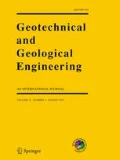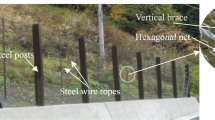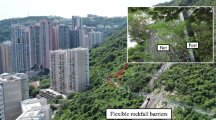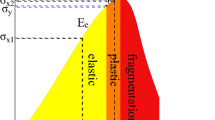Abstract
Due to limitations associated with field tests and equipment, the majority of the research conducted to evaluate the mechanical behaviour of rockfall protection barriers considers only free-falling rocks when simulating the actual situation. Based on this fact, this study introduces ψ, the ratio of the rotational kinetic energy to the kinetic energy of a rockfall, to study the rotational effect and to achieve an optimal design. LS-DYNA is used to analyse the dynamic response of the system under the impact of a rolling rock. The results indicate that a rolling rock is an adverse condition. As ψ increases, the rock displacement decreases with a clear outward rolling, which causes greater deformation of the energy dissipater of the upper support rope and greater displacement of the free end of the steel post. As ψ approaches 0.2, the tensile forces of the upper support rope and the anchor rope reach their peak values, which are 39% higher than the corresponding values when ψ is 0. Additionally, the maximum forces of the steel post and net increase by 29 and 20%, respectively. The energy consumption of the break rings and wire ring net decrease linearly. However, the slide energy and friction energy increase linearly. To facilitate further research, correction coefficients that incorporate the effect of a rotational impact and formulas that include a relation between ψ and the force of each component are obtained through curve fitting.















Similar content being viewed by others
Abbreviations
- V :
-
Translational speed of the rockfall
- V 0 :
-
Total speed of the rockfall
- H :
-
Height of the rockfall
- g :
-
Gravitational acceleration
- α :
-
Slope angle
- k :
-
Resistance coefficient of the rockfall along the hillside
- E a :
-
Total energy of the rockfall
- E va :
-
Translational kinetic energy
- E ra :
-
Rotational kinetic energy
- J :
-
Moment of inertia
- ω :
-
Angular velocity of the rockfall
- ψ :
-
Ratio of the rotational kinetic energy to the translational kinetic energy
- H f :
-
Horizontal distance between the anchorage point of the anchor rope and the block centroid
- H v :
-
Vertical distance between the lower surface of the block and the lowest end of the support rope
- H max :
-
Maximum block displacement
- F max :
-
Maximum internal force of each component
- σ max :
-
Maximum internal stress of the steel post
- η :
-
Correction factor that considers the rotation effect
References
Buzzi O, Spadari M, Giacomini A et al (2013) Experimental testing of rockfall barriers designed for the low range of impact energy. Rock Mech Rock Eng 46(4):701–712
EOTA (2012) Guideline for European technical approval of falling rock protection kits (ETAG 027) (February, Brussels)
Gentilini C, Govoni L, Miranda SD et al (2012) Three-dimensional numerical modelling of falling rock protection barriers. Comput Geotech 44(44):58–72
Gentilini C, Gottardi G, Govoni L et al (2013) Design of falling rock protection barriers using numerical models. Eng Struct 50(3):96–106
Glover J, Volkwein A, Dufour F, Denk M, Roth A (2010) Rockfall attenuator and hybrid drape systems-design and testing considerations. In: Proceedings of the AGS, Tunisia
Gottardi G, Govoni L (2010) Full-scale modelling of falling rock protection barriers. Rock Mech Rock Eng 43(3):261–274
Hu H (1989) Collapse and rockfall. China Railway Publishing House, Beijing (in Chinese)
Koo RCH, Kwan JSH, Lam C et al (2017) Dynamic response of flexible rockfall barriers under different loading geometries. Landslides 14:905–916
Moon T, Oh J, Mun B (2014) Practical design of rockfall catchfence at urban area from a numerical analysis approach. Eng Geol 172(5):41–56
National Council (2009) Colorado’s full-scale field testing of rockfall attenuator systems. Transportation Research E-Circular
Spadari M et al (2013) Statistical evaluation of rockfall energy ranges for different geological settings of New South Wales, Australia. Eng Geol 158(8):57–65
Suits LD, Sheahan TC, Castro-Fresno D et al (2009) Design and evaluation of two laboratory tests for the nets of a flexible anchored slope stabilization system. ASTM Geotech Test J 32(4):315–324
Volkwein A (2005) Numerical simulation of flexible rockfall protection systems. In: Proceedings of the international conference on computing in civil engineering, July 12–15, 2005, Cancun, Mexico
Zhao S, Zhixiang Y, Wei T et al (2013) Test study of force mechanism and numerical calculation of safety netting system. China Civ Eng J 46(5):122–128 (In Chinese)
Acknowledgements
The work of this study was supported by the National Natural Science Foundation of China (Grant Nos. 51408498, 51678504), the foundation of the State Key Laboratory of Geohazard Prevention and Geoenvironment Protection (Grant No. SKLGP2016K013) and the Fundamental Research Funds for the Central Universities (Grant No. 2682017CX006).
Author information
Authors and Affiliations
Corresponding author
Rights and permissions
About this article
Cite this article
Qi, X., Pei, X., Han, R. et al. Analysis of the Effects of a Rotating Rock on Rockfall Protection Barriers. Geotech Geol Eng 36, 3255–3267 (2018). https://doi.org/10.1007/s10706-018-0535-6
Received:
Accepted:
Published:
Issue Date:
DOI: https://doi.org/10.1007/s10706-018-0535-6




